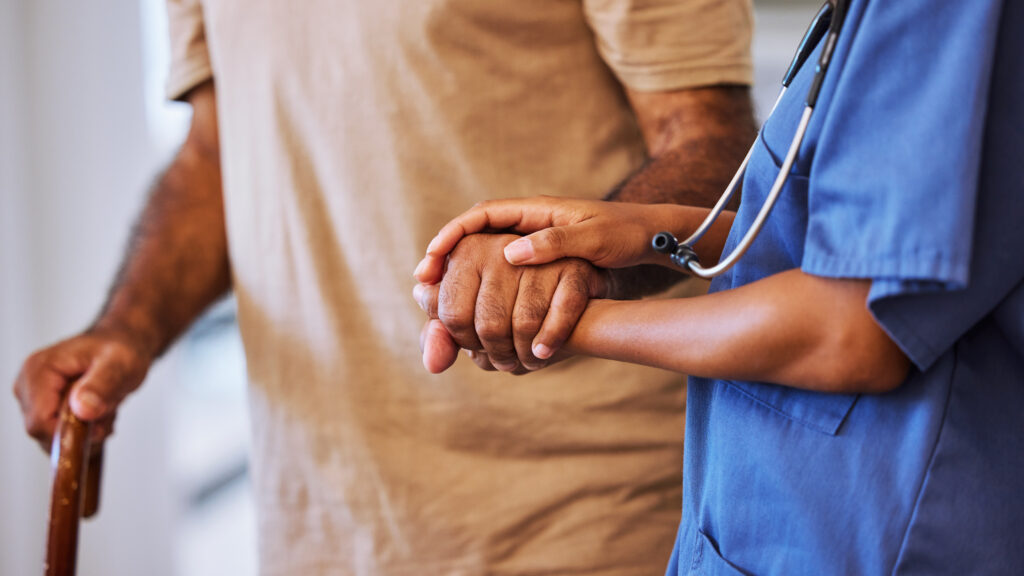As a physician, I was taught to appreciate the clinical importance of human touch for our physical and mental health. As a human being, I worry about its loss. And as a dermatologist, I know what that loss may mean for the loneliest and most vulnerable among us.
Scientific studies prove that human touch — whether it be a quick hug, holding a baby, or a professional massage — is important to our mental and physical well-being. Babies who are deprived of touch can die, and even as adults, touch causes our brains to release oxytocin, dopamine, and serotonin while reducing stress hormones like cortisol and norepinephrine. Touch builds our immune systems, helps our bodies fight infection, and can help regulate digestion and sleep. Even petting a dog or cat can slow heart rate and lower blood pressure.
advertisement
For my psoriasis patients, empathic touch during medical exams serves all of these purposes and more. Psoriasis is a chronic skin condition that causes raised, red patches on the skin. Though not contagious, its appearance has historically been misunderstood, leading to stigma and fear. While society understands psoriasis better in 2024, for centuries, people with psoriasis (between 2-3% of the population) were misunderstood and unfairly isolated. For patients with this condition, touch can be an affirmation of their humanity.
Before the pandemic, healing touch was a natural part of my patient interactions. However, Covid-19 brought a dramatic shift. With social distancing, protective gear, and heightened fear of contagion, physical touch unfortunately became a rarity in the exam room setting. Now that the crisis has waned, the challenge is how to balance safety with the need to bring healing touch back into care. Recent changes — both good and bad — have virtually banished the consistent touch that I used to take for granted. Technology allows millions of us to work from home, often alone. The Covid pandemic in some cases ended the practice of shaking hands, hugging, and other ways of greeting each other, particularly for those of us in the medical field.
Increasing awareness of the pervasiveness of unwanted touch has been an important step toward protecting individuals’ boundaries. However, it has also introduced new complexities, particularly for doctors. Many physicians who once used touch — with permission — to connect with their patients now avoid touch whenever possible for fear of misinterpretation.
advertisement
What’s more, the rise of technology in medicine, while beneficial in many ways, has further reduced the use of empathic touch in patient care. Virtual visits (which have brought health care to millions who might otherwise do without it entirely) lack the personal connection that a physical exam provides.
How can physicians get back to being comfortable with physical contact now that it has dwindled, while also figuring out which patients are comfortable with it? We need to make sure we ask for permission, respecting each patient’s boundaries and what they personally need for healing and connection.
When I see my dermatology patients, I am cognizant that, due to their skin conditions, many of them have different experiences with and feelings about touch — and the lack of it. I want to show them that their skin disease is not contagious and is not something to be feared. I might hold their hand, raise their arm, or help them turn their body.
“I am not afraid of you. Your skin isn’t scary. I care about you.”
All of this has been said without words.
Of course, there are some people who do not like to be touched — who aren’t “huggers.” But for many of us, it is a comfort and a connection that is as essential to our health as seeing our doctor is. Patients and doctors alike have told me that they miss the presence of healing touch in their interactions. One patient said that her primary care doctor had not touched her at all during her visit, making her feel that she hadn’t been “seen” — that the examination wasn’t thorough. “I felt like I was just being processed,” rather than healed, she told me.
Perhaps this is the crux of the issue: As physicians, we do more than just process patients. As internist and Massachusetts Medical Society President Dr. Barbara S. Spivak explains, “For us to help them heal, we need to understand who they are, what is important to them, and what in their lives is impacting their health.”
We are called caregivers for a reason, and one of the most important ways humans demonstrate care is through healing touch: “Whether it be examining them, or touching their knee or their shoulder when they are describing pain — emotional or physical — helps to transmit that sense of acceptance, understanding and caring that is so vital,” Spivak said.
advertisement
And so, as doctors, we should not lose sight of the value of healing touch. Seeing a patient doesn’t just mean looking at them with our eyes. For many, it also means reaching out a hand.
Alexa B. Kimball, M.D., M.P.H., is CEO of Harvard Medical Faculty Physicians at Beth Israel Deaconess Medical Center in Boston.

